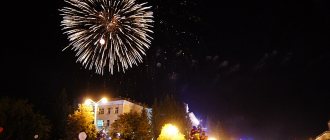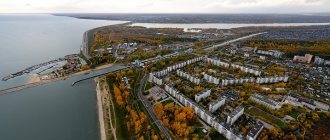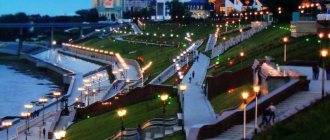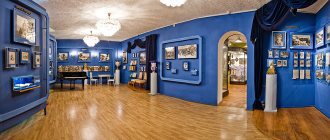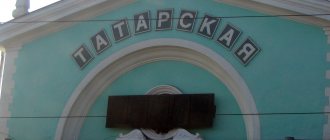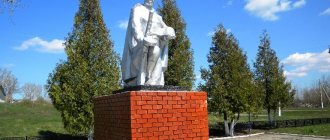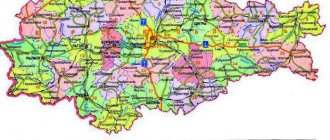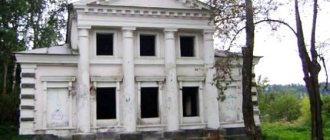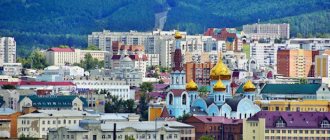In the southeast of the West Siberian Plain there is an amazing and picturesque region. Its past is covered in legends and traditions, and the land still hides secrets and mysteries.
The Novosibirsk region is one of the most hidden areas of the Siberian land. Although 5 of the territory is covered with forest, there is enough space for both small villages and large cities. The cultural, historical and industrial center of the region is Novosibirsk. The history of the region and its capital is reflected in historical and cultural monuments, unique collections of numerous museums.
Novosibirsk State Academic Opera and Ballet Theater (NSATOiB)
Novosibirsk State Academic Opera and Ballet Theater
Address: Novosibirsk, Krasny Prospekt, 36
The theater building is not only one of the main cultural and architectural monuments. It first opened its doors in 1945 after the end of World War II, although construction began back in 1931. Until that moment, unique exhibits from the Hermitage, the Tretyakov Gallery and other masterpieces of art were stored inside the unfinished building.
The Opera and Ballet Theater is shrouded in many secrets. The most famous legend is that under the building there is a real underground city, which includes 5 levels. But the rumors were not scientifically confirmed, remaining only a beautiful mysterious story.
Inside the building, antique statues deserve special attention, capable of sending visitors back in time for a few minutes. The interior is not sophisticated or complex, but it looks very elegant. Huge crystal chandeliers shed light from the ceiling. But the greatest delight is caused by the huge dome towering over the building and the bright flickering lights that illuminate the theater at night.
The Novosibirsk State Academic Opera and Ballet Theater is located on the central square. Its size is amazing and attracts the attention of tourists passing by. You can notice the building on many souvenirs and postcards, because the theater is considered one of the calling cards of the city. The theater's repertoire includes many famous productions, both Russian and well-known foreign directors.
Route around the sights of Novosibirsk for tourists for 1-2 days
There are many attractions in Novosibirsk to suit every taste. The length of the city is more than 50 km. The following tables will help you decide on the cultural program route. Most museums can be visited from Wednesday to Friday from 10:00 to 18:00, on Saturday and Sunday opening hours: 11:00 to 19:00.
Novosibirsk has original attractions:
| Name | Address |
| Traffic Light Monument | intersection of the street Sibrovkom and Serebrennikovskaya |
| Monument to trade workers - seller and buyer | intersection of the street Krylov and Kamenskaya. |
| Monument to a business woman | st. Michurina, 3 |
| Monument to the letter "A" | st. Kamenskaya, 1 |
| Monument to Recumbent Abstraction | st. Kamenskaya, 1A |
| Monument to Koshchei the Immortal and the Serpent Gorynoch | st. Kirova, 44A |
| Monument to the Guardian Angel | st. Sverdlova, 21 |
| Monument "Happiness is under construction" | Krasny Prospekt, 30 |
| Monument to the Janitor | st. Bohdan Khmelnytsky |
| Monument to sausage | st. Komsomolskaya, 23A/1 |
| Monument "Metal Throne" | st. Deputatskaya, 38 |
| Monument "Love" | st. Sovetskaya, 14A |
| floating fountain | Ob water area, area of the Urban Origin park |
| Leaning Tower of Pisa | st. Kirova, 25 |
| Big iron book "Capital" | st. Maxim Gorky, 78 |
| 100-apartment building | Krasny Prospekt, 16 |
| Alexander Nevsky Cathedral | st. Sovetskaya, 1A |
| John Lennon Memorial Wall | st. Chelyuskintsev, 44 |
| Park named after CM. Kirov | st. Stanislavsky, 1 A |
| 86-meter skyscraper "Batman" | st. Kommunisticheskaya, 50 |
| Monument to M.I. Glinka | st. Sovetskaya, 31 |
If a traveler does not want to choose a route on his own, there are ready-made tours:
| Name | Places to visit | Cost, rub. for 1 person | Duration, hours |
| Novosibirsk in 3 dimensions | Transib – Akademgorodok – rock abode | 5000 | 7 |
| A long walk around Akademgorodok | Akademgorodok | 3500 | 5 |
| Architectural eras of Novosibirsk | City center | 3000 | 3 |
| To Suzun for a Siberian coin | Suzun | 12000 | 12 |
| “Alice”, “Poet”, “Garden of Eden” and other miracles of Bogdasha | Kalininsky district of the city | 1250 | 12 |
| Kolyvan. Failed Novosibirsk | Village Kolyvan – Church of Alexander Nevsky | 5000 | 5 |
| Contrasts of the Left Bank | Leninsky district of the city | 1250 | 2,5 |
| Legends and myths of the city of Novosibirsk | Historical city center | 4000 | 3 |
| Lights of Novosibirsk | city | 4000 | 3 |
| Tales of the Kolyvan Land | Kolyvan | 350 | 4,5 |
| Rope park | Zaeltsevsky Park | 300 | 0,5 |
| City outskirts | Vladimir Cathedral of the Mother of God, eye microsurgery center, sports | 3750 | 3 |
| Village of Novosibirsk hydroelectric power station | ObHPP area | 3750 | 3 |
| Tomsk writing | Museumified monument | 4621 | 1 day |
Novosibirsk has many monuments, attractions and cultural centers, a visit to which will give those wishing a lot of vivid impressions and enrich them with new knowledge.
In addition to stationary entertainment, Novosibirsk constantly hosts festivals and concerts of Western rock bands.
Article design: Svetlana Ovsyanikova
House-Museum of P.P. Bazhova
Address: Novosibirsk region. With. Bergul, st. Central, 29
The famous Ural storyteller stayed for several months (March-June 1919) in a small village in the Novosibirsk region. Here he not only rested his soul, sought inspiration for writing new works, but also became the first teacher at a local school. In memory of P.P. Bazhove native. Bergul - A.M. Belova began to found the museum. The grand opening took place in January 1984.
The interior of the main halls is designed based on the fairy tales of P. P. Bazhov. The decorations are made using malachite and mosaics. One of the rooms is equipped with a writer's office. Here you can see the table at which Bazhov worked, a hanging mirror and an antique cabinet. The walls are hung with memorable photographs of the writer, books published in different years, letters from the writer and his students are displayed on the shelves. Among them there are several unique specimens, preserved in the singular. In total, the collection of the house-museum includes more than 2 thousand exhibits.
Every year, museums host “Bazhov Days” - events dedicated to the birthday of the Ural storyteller.
The exhibition dedicated to the writer is not the only one: 3 more interesting exhibitions are open in the house-museum:
- Agricultural tools for processing flax and hemp;
- Stove corner;
- Household items of the 19th – 20th centuries.
What to see in Novosibirsk with children
There are many remarkable places for children in Novosibirsk. Here you have the opportunity to interact with animals in the zoo and enjoy performances for young visitors in theaters. The children's railway will not leave anyone indifferent.
Novosibirsk Zoo
Zoo named after R. A. Shilo in Novosibirsk at st. Timiryazevskaya 71/1 has an area of 65 hectares. It is one of the largest in the country. There are 770 species here, more than 350 of which are listed in the International Red Book. Approximately 180 species are listed in the Red Books of Russia and its regions.
The zoo has one of the best collections of felines and mustelids; they are bred here. The zoo's logo depicts a snow leopard. Holidays are organized at the zoo site, youth clubs and a riding school operate.
Planetarium
The idea of creating a planetarium in Novosibirsk belongs to L. L. Sikoruk and A. G. Savelyev. The initiative was supported by city universities and enterprises. In 2007, a favorable place was chosen for the construction of the planetarium - the Klyuch-Kamyshenskoye plateau. The construction was timed to coincide with the 50th anniversary of space flight and was included in the federal plan as one of the main events.
In 2012, the planetarium allowed visitors in. The building has a domed roof made of steel structure and perforated sheets, forming a spherical display screen. The main building is connected to 2 observatory towers. Nearby stands the Foucault Tower with a 15-meter pendulum demonstrating the rotation of the Earth.
There is an open observation deck on the roof of the tower. The planetarium hall is equipped with the latest projection technology. Here you can see a three-dimensional dynamic image of planets and their satellites, stars and nebulae. The public observatory houses modern equipment.
On the 1st floor of the planetarium there is a film studio. There are plans to develop 7.5 hectares. territory of the planetarium, a large sundial will be installed on it, and meteorological instruments will be placed to monitor the weather.
Globus theatre"
Novosibirsk Academic Youth Theater "Globus" is located on the street. Kamenskaya, 1. The first stationary theater was founded in 1930 by a group of enthusiasts from the Leningrad Youth Theater. For 5 years the troupe worked in the building of the Pioneer cinema, then the performances were shown in the current chamber hall of the Novosibirsk Philharmonic. From 1942 for 18 months, NTUZ left his hometown.
The war years shaped the theater's classical repertoire. In 1984, a building was built in the form of a sailing ship, specifically for the needs of the Novosibirsk Academic Youth Theater. Performances are held in two halls, a large one with 500 seats, and a smaller one with 118 seats.
Today the repertoire, designed for all age categories, is constantly updated, about 9 premieres are released a year. The theater regularly participates in theatrical shows and receives awards and prizes.
Toy railway
There is a children's railway in Zaeltsevsky Park in Novosibirsk. It was designed at the Sibgiprotrans and Zheldorproekt institutes. The grand opening took place in 2005. This is a real working small railway, and not just an attraction, its length is 5.3 km, the duration of such a journey will take 105 minutes.
Passengers are transported by 3 24-ton diesel locomotives and a dozen children's passenger carriages and trains. There are platforms and a train station here. High school students who have undergone special training work on the railway.
Puppet Theatre
Regional Puppet Theater in Novosibirsk is located on the street. Lenina, 22. It has been operating since 1934. At first, productions of their own plays were shown on stage, then works by Russian classics were included in the repertoire.
The theater acquired its own home in 1981, when a school for working youth was adapted to its needs. The building is made in the rationalist modern style. In 1999, the construction of the extension was completed, which lasted 10 years. In recent years, the theater has been going on tour and participating in world symposiums and festivals abroad.
At the end of September 2011, at the cultural and leisure center named after K.S. Stanislavsky, at st. Stanislavsky, 12, another children's theater opened
Novosibirsk Museum of Railway Equipment
Address: Novosibirsk, st. Seyatel, st. Razdolnaya, 35
Novosibirsk Museum of Railway Equipment
Every year, more than 50 thousand tourists come to look at the numerous exhibits, stroll through the huge halls and see with their own eyes the model trains collected in the museum. It is named after the honorary veteran railway worker N.A. Akulin. In 1966, he had the idea of creating a museum, and every year he increasingly brought it to life. The grand opening took place in 2000. The first visitors saw only 63 exhibits, but this small number continued to grow.
Museum visitors will be able to see real railway equipment, individual cars or complete trains. They date back to the 19th-20th centuries, and each of them was used for its intended purpose several decades ago. The museum covers an area of 3000 m². It is divided into several thematic zones, each of which is dedicated to a specific type of railway transport: steam locomotives, electric locomotives, diesel locomotives, electric trains, individual cars and railway equipment.
Architectural sights of Novosibirsk
Novosibirsk is a relatively young city, founded in 1893, and consists of 10 districts. Each of them has its own architectural attractions, which are admired by locals and tourists. Until 1926, the city was called Novonikolaevsk.
Train Station
The Novosibirsk railway station has been operating since 1939. At the time of its opening, it was the first largest station building in the USSR. In 2000, the Sibzheldoproekt Institute completed the renovation of this premises.
The building has a rectangular shape, with a variable number of floors, up to 8 floors, and is included in the composition of the station area. It is made in neoclassical style. The external walls are finished with brick and cinder blocks, the basement is plastered. There is an arch with stained glass on the main facade.
The walls and floor inside are lined with marble and granite. Oak wood was used for window blocks. Two-tier Empire style chandeliers hang on the ceilings, there are 3 of them in total. The base of the chandeliers is decorated with stucco. The ventilation grilles have a hammer and sickle on them.
The stairs are predominantly made of reinforced concrete. There are monitors above the ticket office windows that provide information to travelers. There are sculptures of people greeting and seeing off on the platform. The building has historical and cultural value, as it is the largest railway building in Siberia and the starting point of Tursib.
Mansion M.D. Zhernakova
The monuments of Novosibirsk convey the mood of an apolitical city. One of these architectural monuments is the mansion of merchant Maria Danilovna Zhernokova, located in the central part of the city. It was built in 1912. The one-story brick house belonged to the famous owner of several houses for rent in the center of Novonikolaevsk.
The facade of the house from the street. The Communist building has an entrance decorated with pilasters and patterned bricks. There are narrow partitions between the five windows with rounded upper corners. Under the window openings in the horizontal plane there are 3 relief elements of “diamond rustication”.
The walls are completed by a multi-stage frame, from which two attics with profiling, through arches and a tower protrude. On the eastern corner of the roof, a parapet column topped with a tower was erected. The western wall is connected to the wall of the two-story house of the merchant I. S. Efremov.
The monument is valuable because it conveys the atmosphere of a residential building in a pre-revolutionary city. In 1998, the building was redesigned for new functions.
Mansion R.M. Kopylova
Furrier, Chistopol tradesman, Rodion Martemyanovich Kopylov, in 1901 built a two-story house at the address: st. Krasnoyarskaya, 112.
The first floor of the house is made of brick. To build the second floor, logs covered with planks were used. The window openings on the first floor are framed by brick frames. A pentagonal balcony with 4 columns and a spire on a domed roof is attached to the façade.
The balcony rests on wooden struts. The platbands of the second floor windows, balcony railings and the cornice of the building are decorated with elegant wood carvings, reminiscent of fine lace. Now the mansion is valuable as a monument of stone and wooden architecture, and is an example of an urban estate of the early 20th century.
House of P.M. Zeidina
Brick house on 2 floors on the street. Kommunisticheskaya, 45 was built by the merchant P. M. Zeidin for two years from 1912 to 1913. Now the building bears the significance of an architectural monument of regional significance.
The building has features of modernism and eclectic style, which were widely used in the provincial architecture of Novonikolaevsk before the revolution. XX century. The estate is built in the letter L with an arch leading to the courtyard on the main facade, above which there is a triangular bay window with a tent and a spire. On the second floor there is a balcony with lattice fencing.
Above it there is a dormer window in the shape of a semicircle. The first floor with large windows was intended for retail shops. The second floor with small windows was residential. The window openings have rounded corners and are framed with brickwork. The western wall of the house adjoins the one-story estate of the merchant Zhernakova M.D. After renovation, the building was redesigned.
House with mezzanine
In the first years of the 20th century on the street. Chaplygina, 36, a one-story house with a mezzanine and a wooden gallery was built. The facade of the house is decorated in Art Nouveau style, decorated with forged elements.
The abutments of the gate adjacent to the western wall are lined with small brick plastic, finished in the same way as the corner pilasters of the building, and finally towers are installed. A relief mezzanine with a balcony rises above the central part of the building. The corner pilasters of the mansion are continued by eclectic towers with helmet-shaped roofs.
Information Technology Center building
The Information Technology Center was built in 2012 and is a complex of 3 buildings of 14 floors each, an ICT cluster in Akadempark. The towers are built at an angle, connected by a gallery at the level of the penultimate floor.
For the decoration of the facade we used:
- orange porcelain tiles;
- marble;
- ceramic tiles;
- decorative plaster;
- glass;
- light horizontal stripes.
The complex is visible from anywhere in Akademgorodok. On the walls you can see the broadcast of graphics and photos.
Alexander Nevsky Cathedral
Address: Novosibirsk, Krasny Prospekt, 1a
Alexander Nevsky Cathedral
Construction, headed by engineer N.M. Tikhomirov, began in 1897. 2 years later, the building was completely completed. The temple was painted by the most talented icon painters from the Tomsk workshop of I. A. Pankryshev.
The cathedral was illuminated in 1899. The building underwent numerous reconstructions and somewhat changed its original appearance. The temple was built primarily in the neo-Byzantine style, which was most popular at the turn of the 19th and 20th centuries. Its features can be seen by looking at the central squat dome resting on a low, wide drum.
The interior of the building has practically not been preserved since its construction. Restorers carefully tried to find traces of previous fragments of frescoes on the wall, but their attempts were in vain. Painting dating back to the last century was found only in the drum. It depicts various full-length figures. Due to the fact that the pre-revolutionary painting cannot be restored, a new one was made. The artist P. A. Milovanov coped with his task perfectly. The new painting gave the temple a certain idleness and mystery. It is almost impossible to take your eyes off it, because when entering the cathedral, bright picturesque paintings are the first thing that catches your eye.
Main city monuments
Monuments of Novosibirsk include several special sculptures that tell citizens and tourists about significant historical stages of the region and country.
Glory Monument
A monument to Siberians who participated in the Second World War was erected on the street. Stanislavsky in Glory Square in 1967
The memorial ensemble with an area of 2 hectares includes:
- Square of Sorrow and Sorrow with the monument to the Sorrowful Mother;
- bowl of eternal fire;
- 5 10-meter obelisks. On one side, they contain the data of Novosibirsk residents who died at the front. War scenes are depicted on the back.
In the first years of the 20th century. The “Chapel of St. George the Victorious” was installed here, dedicated to the Siberians who died in the hostilities of the last century. In 2005, the composition was replenished with the Alley of SS Heroes and full holders of the Order of Glory. There are 270 names engraved on concrete steles dedicated to Novosibirsk residents and residents of the region. The memorial composition includes military equipment.
Revolution Heroes Square
This memorial complex is located in the central part of Novosibirsk.
The composition includes:
- Mass grave of 104 victims of the Civil War, and mass grave of the Novonikolaevsk Council of Workers', Peasants' and Soldiers' Deputies
- The graves of P. E. Shchetinin, the leader of the Soviet Siberian partisan movement, and A. F. Lejeune, a participant in the Paris Commune. In the early 70s, the second was reburied in Père Lachaise.
- The panel, located on Red Avenue, serves as a reminder of the courage of peasants, workers, and soldiers.
Monument to V.I. Lenin
There are many sculptures of the “Leader of Nations” in Novosibirsk, but the most remarkable one is located on Lenin Square. The opening of the monument was timed to coincide with the 100th anniversary of V.I. Lenin. A bronze sculpture of the leader stands on a gray polished granite pedestal.
On the right side of her are the figures of a worker, a soldier and a peasant. On the left hand of the monument there is a guy with a torch and a girl with ears of corn. The composition carries the meaning of monumental art of federal significance.
Monument to V.S. Vysotsky
On the street Chaplygin in 2005, a monument to V.S. Vysotsky was unveiled. Marble pedestal on which V.S. stands barefoot. Vysotsky, made in the form of a blade with a red inscription. The poet's right hand is raised up; in his left hand he holds a guitar.
Initially, Yorick’s skull lay at the feet of Vladimir Semyonovich, but after some time he disappeared. In 2006, an alley of bards was organized next to the monument.
Umrevinsky prison
Address: Novosibirsk region, Moshkovsky district, pos. Umreva (about 100 km from Novosibirsk)
Umrevinsky prison
One of the most significant monuments in the history of the Novosibirsk region. Ostrog at the mouth of the river. Umrev was built on the initiative of the Russian Cossack Alexei Kruglikov at the beginning of the 18th century. and became the first defensive structure on the southern border of the Tomsk district from raids of nomadic tribes and the first administrative unit on the territory of the Novosibirsk region.
Initially, the Umrevsky fort had the appearance of a regular quadrangle. A defensive wooden wall with 3 watchtowers on the outside was surrounded by a moat filled with water. Inside the fort, a temple to the Three Saints, grain storage barns and a clerk's house were built.
None of the buildings have survived to this day, but archaeologists managed to find the remains of the building foundations and walls. Based on the findings, the chapel, the fort church and one of the towers have already been reconstructed.
Umrevsky fort is included in the list of architectural monuments of federal significance.
Museum-temple in honor of the new martyrs and confessors of the Russian Church at the Holy Spring
Address: Novosibirsk region, Iskitim, Lozhok district
For 27 years (1929-1956), the Iskitim penal camp was located on this piece of land (point No. 4 of the SibLAG). Tens of thousands of people served their sentences here in cruel conditions. Along with the brutal murderers, innocent citizens who had become victims of repression were kept in the cells of the camp. Many of them died from hard labor, bullying and beatings by guards. In the early 1930s. Several clergy were shot in the camp courtyard. The bodies of the martyrs were thrown into a freshly dug trench and covered with earth, although some of them were still breathing.
Years later, at the site where prisoners were executed, a key emerged from the ground. The water from the spring is considered holy. People believe in its miraculous healing power and come here in the hope of getting rid of illnesses. A font and a small chapel were built next to the source. On a small hill not far from the Holy Key stands the Temple, which opened its doors to believers in 2015. In July 2022, a museum was opened in the church on the ground floor; the exhibition is dedicated to the times of repression and persecution of clergy.
Historical and memorial complex "Railway Bridge"
Address: Novosibirsk, Central district
The main monument of Novosibirsk and the calling card of the city is located near the Oktyabrskaya pier.
Work on the construction of the first railway bridge at the intersection of the river. The Ob and Trans-Siberian Railways began in 1893. This year is considered to be the founding of the city of Novonikolaevka, now Novosibirsk. The project of a large-scale structure for those times belongs to the outstanding engineer N.A. Belilyubsky. Four years later, the bridge was put into operation. This event became significant in the history of the development of railway communication in Russia.
The engineering structure across the Ob became the first where metal structures of the cantilever-baroque type were used during the construction process. There were 9 of them in total. The total weight of the ceilings was 270 thousand pounds, and they were manufactured at the Botkin plant. The miracle of engineering technology cost the royal treasury 2 million rubles.
In 1990, it was decided to dismantle the century-old bridge, but one of the spans was still left and turned into a museum exhibit.
